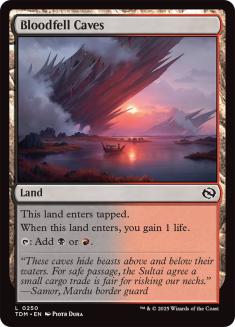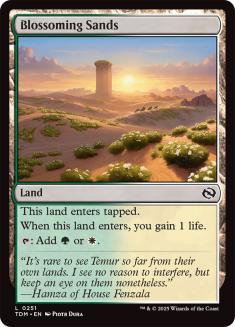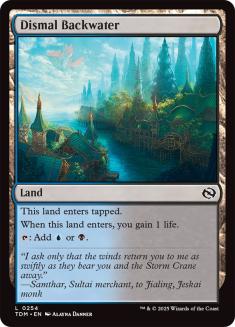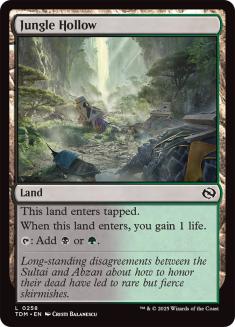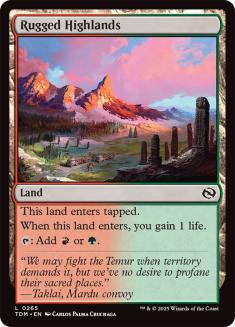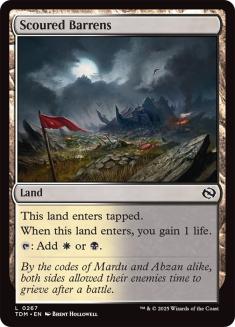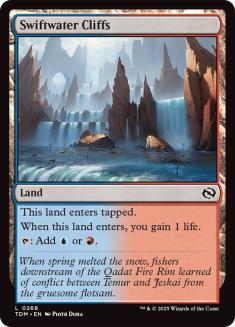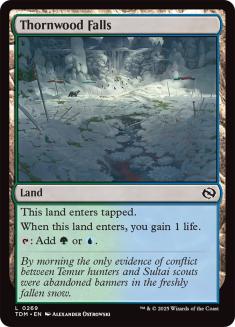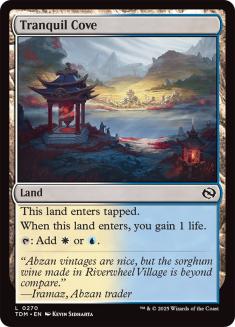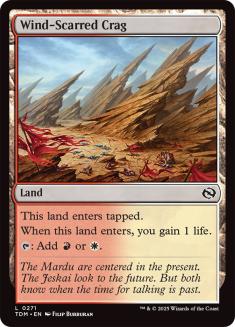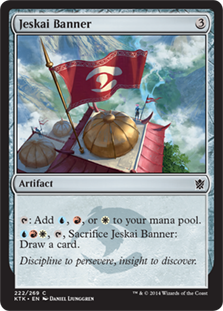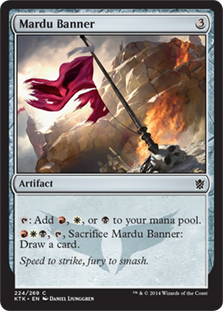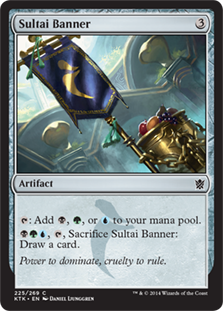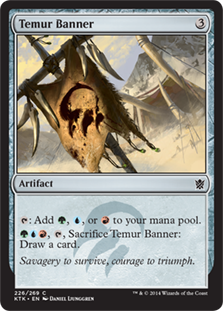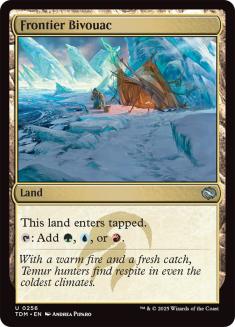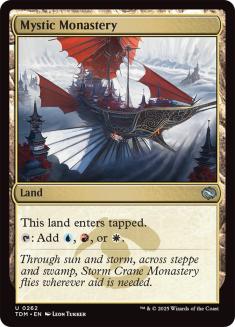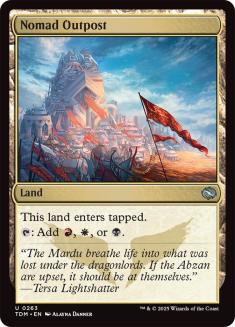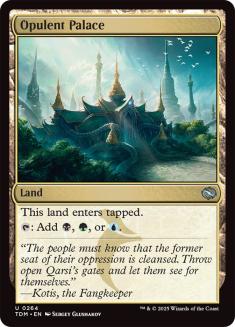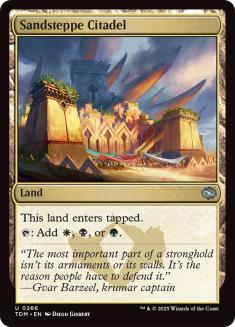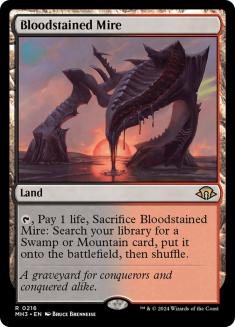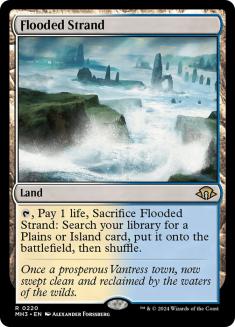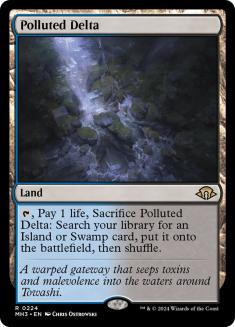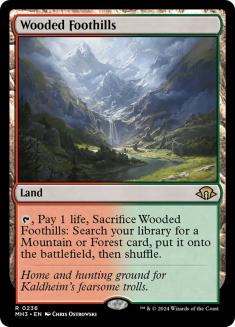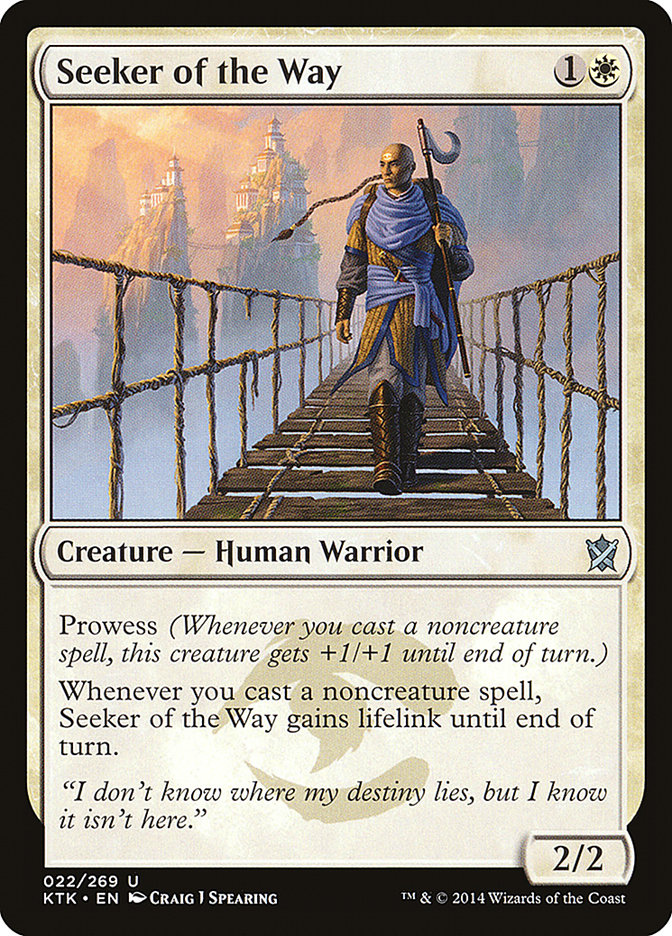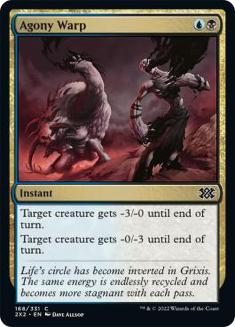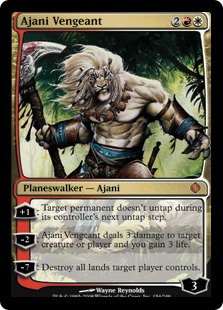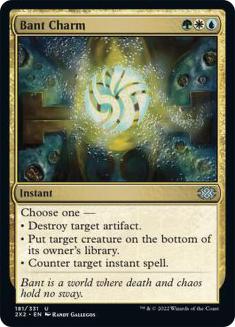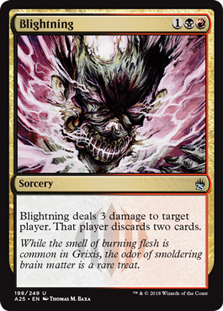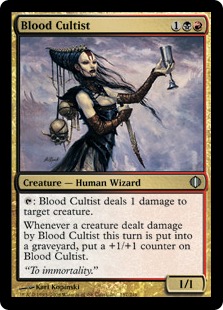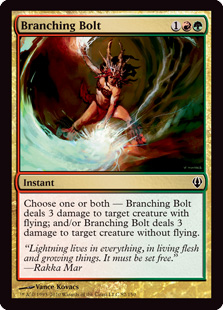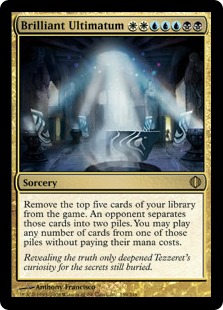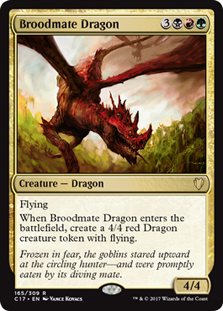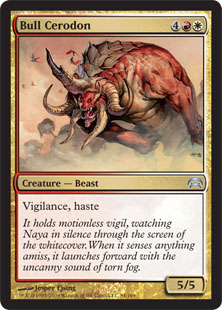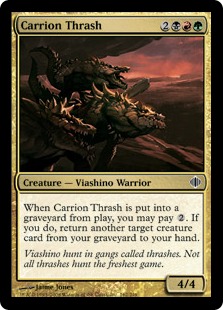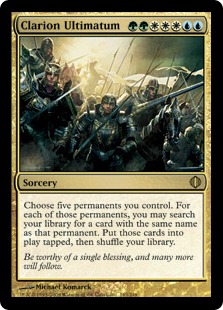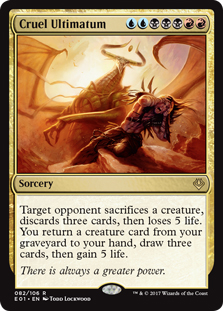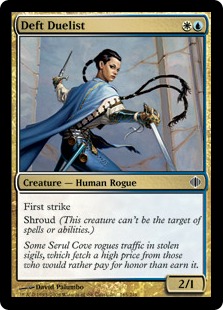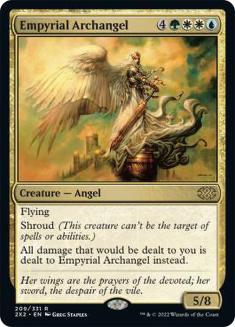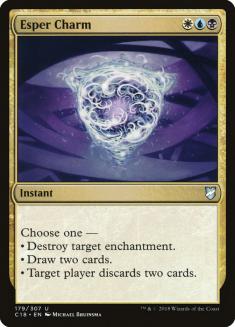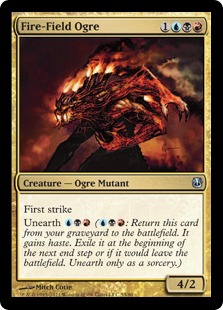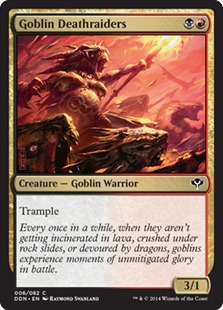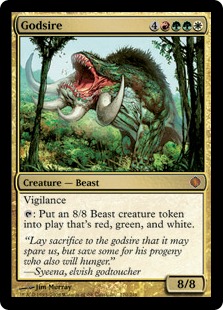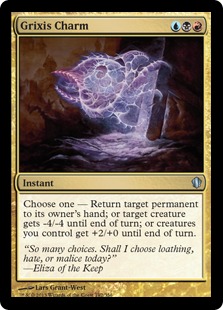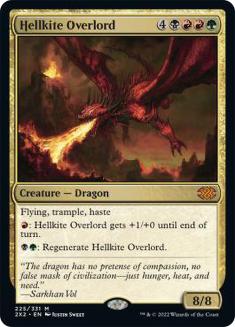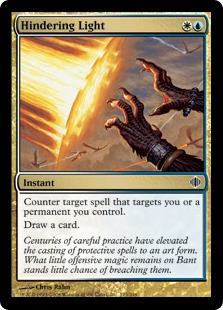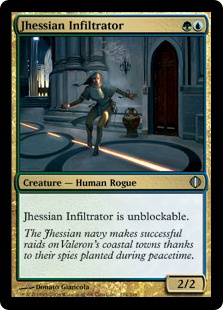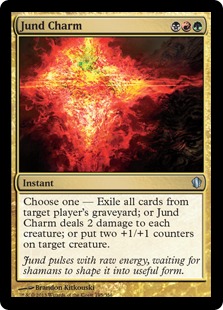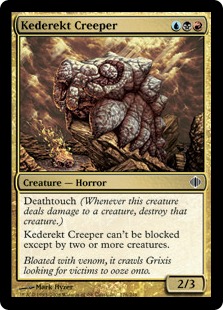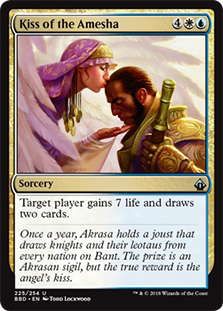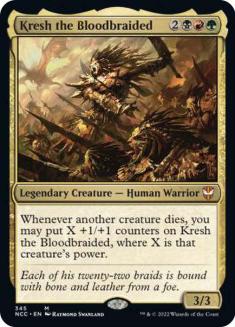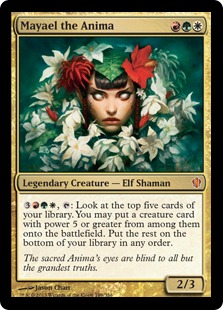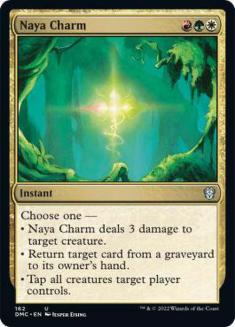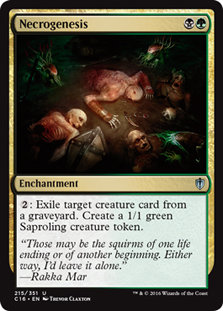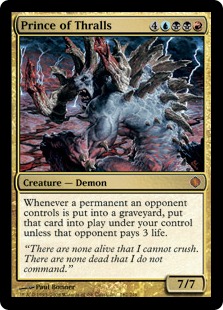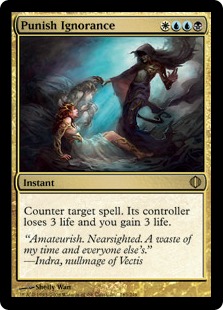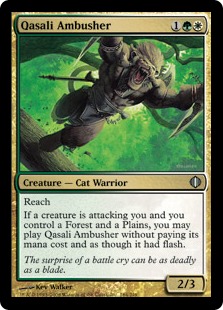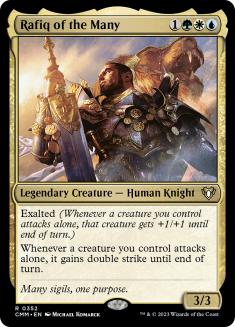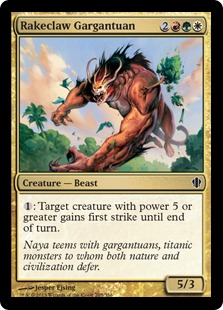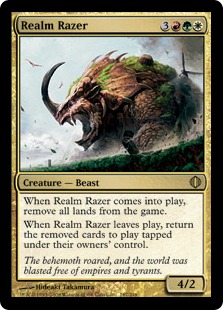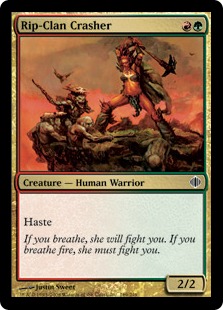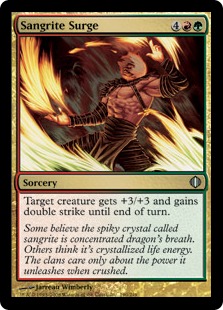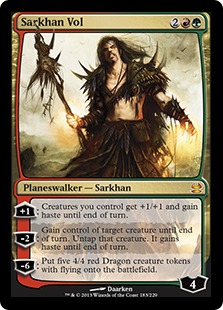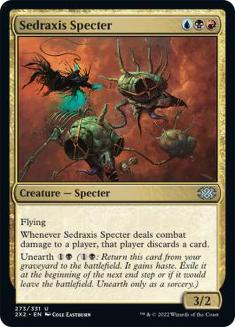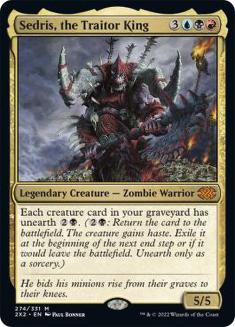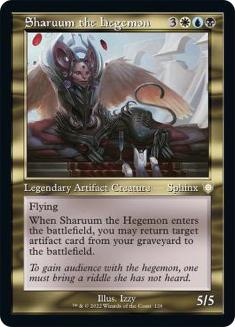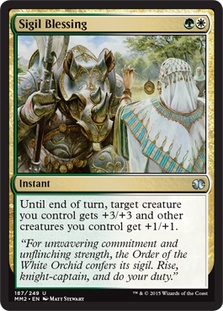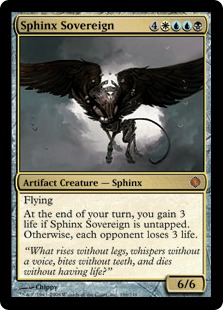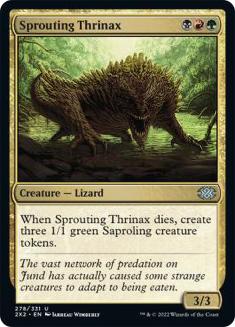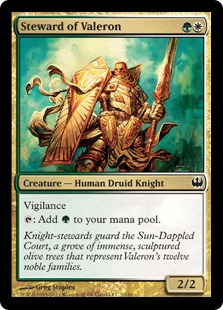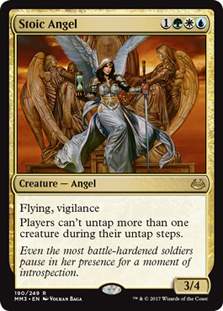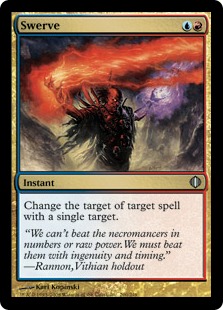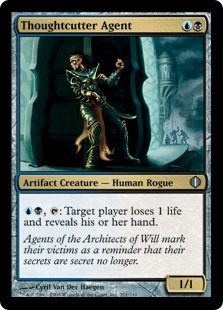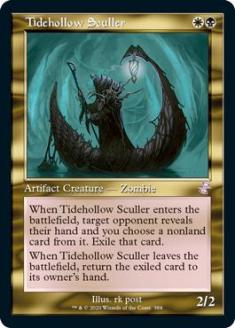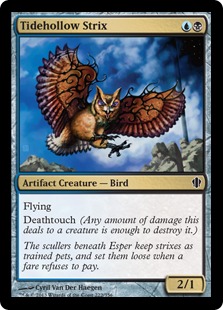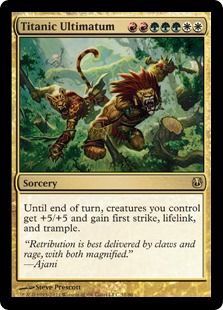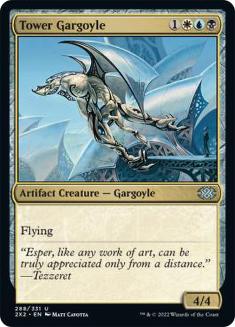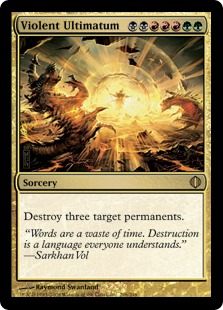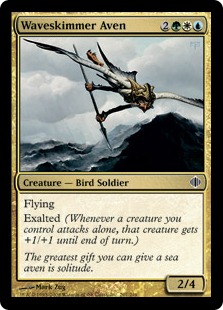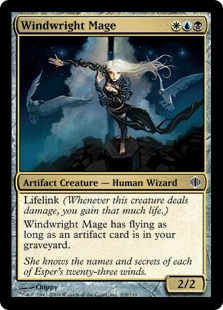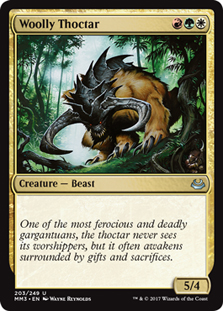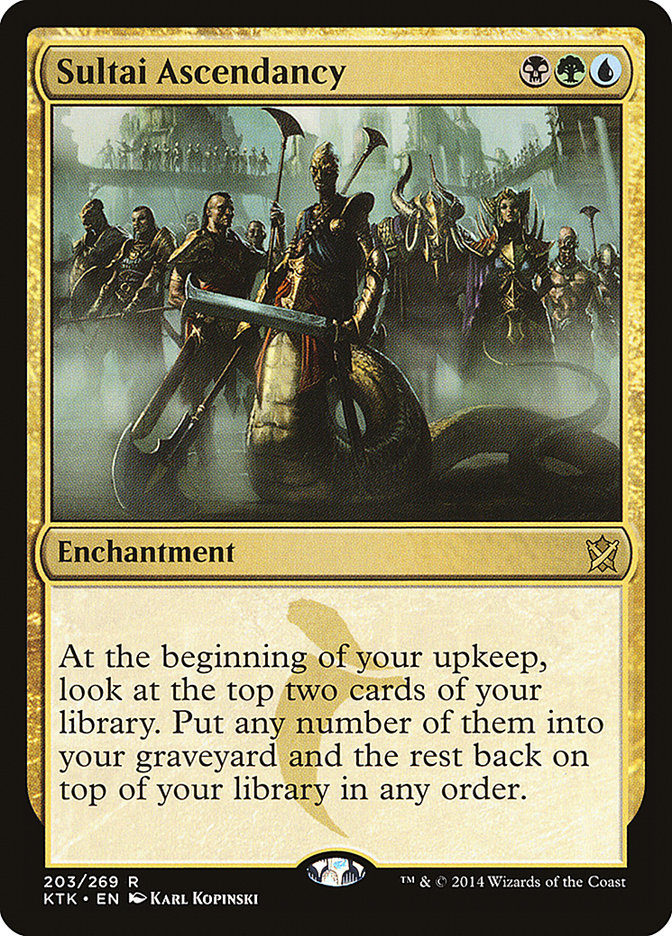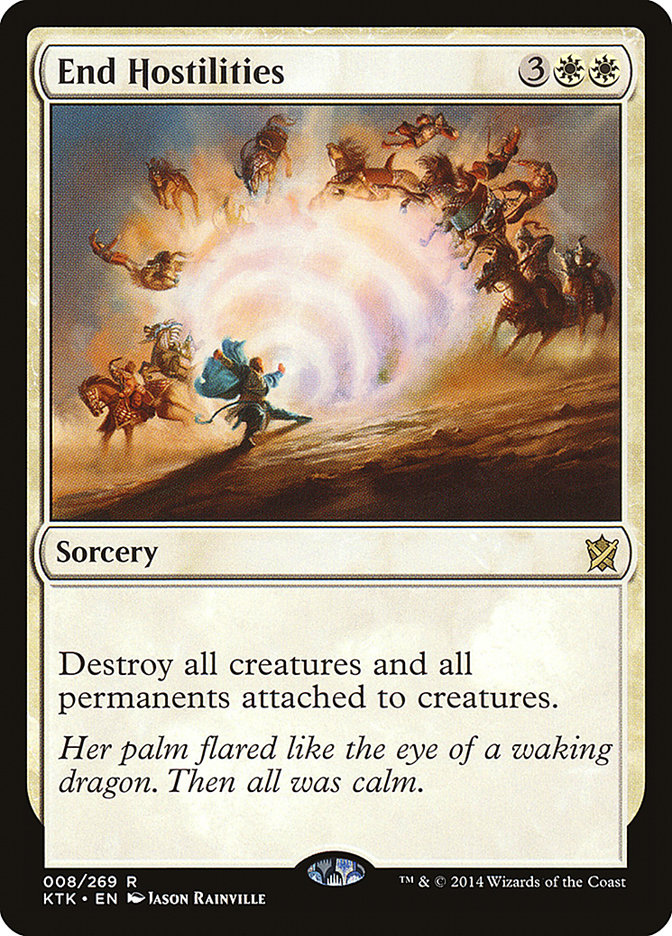Sealed deck formats can be wildly different affairs. I’ve been really looking forward to the shift to a new Sealed format, especially after I learned that
Khans of Tarkir was going to be wedge-based. I have not been particularly happy with the last few Sealed formats, and any change would be welcome. This,
however, seemed rife with possibility.
Before the spoiler was fully out, I definitely felt like I had a ton of hope. I had visions of all of the gold formats of days past. I had basically loved
all of them, especially if they really went for the gold. What would this be like? Would it be similar to Invasion, with color fixing in basically all of
the colors? Would it be closer to Shards of Alara, where Obelisks were joined by tri-lands and panoramas? Or would it be closer to Ravnica or Return to
Ravnica, where you were strongly encouraged to go towards specific color combinations?
One of the things that was discussed on The Mothership was the way that early mana in Khans of Tarkir was such that it overemphasized playing full five
colors rather than encouraging people to play wedges. They seemed to feel like they had solved that problem, but initially I was skeptical. However, after
playing several Khans Sealed decks (albeit seeded Prerelease sealed decks), I actually am quite a bit less skeptical.
Mana is always the building block for any format. A part of the reason that Zvi Mowshowitz made splashes in his latter-day deckbuilding career is
through pushing the bounds of what a deck is capable of with regard to its mana. In Zendikar Constructed, with the Mono-Green Beastmaster deck, and in old,
old Standard (okay, so only 2010) with Mythic, both of these Constructed decks looked at what was possible with mana and just pushed it.
Because of variance, it may be less dramatic in Limited, but it is no less true.
The Building Blocks
If we’re going to begin talking about the mana, we have to have a sense of what it is we’re working with.
I’ve looked at a lot of Sealed decks thus far, and I have yet to see a single one that has had less than ten colorless ways to fix mana.
Again, fair warning, all of these are seeded packs (which I presume means that it is likely that they automatically have two fixers in the seed pack), but
when you have fifteen common colorless mana fixing, five uncommon colorless mana fixing, and five rare colorless mana fixing, that is a big deal.
With 101 commons in the set, that means you’ve got ten shots per pack at a 15% chance of a common colorless fixer. If you do the math, only
roughly 22% of packs will have no common colorless fixers.
Your common fixers are the paired lifegain duals and the banners:
The five uncommons (out of 80) are a little less likely to give you a payoff (only slightly more than 6% for each slot) and with a little more than 82% of
packs not having an uncommon fixer. This does mean, however, that 70% of the time you will have at least one of these cards in your full six
packs.
The rares, obviously, do exist. A little less than 10% of packs will have one of the coveted fetchlands. This means that a little over half of the pools
(~55%) will have none of them. While you can’t count on opening a rare when there are five copies of a similar card and you have six packs, it
does end up adding up. Ultimately, a multicolor land isn’t the same thing as a spell when it comes to determining what you can count on as a building
block, as these multilands acquire a cumulative effect that can be counted on for nearly any deck that is trying to fix their mana. Every multiland is
perfectly serviceable for any deck that is playing the appropriate wedge that it applies to, but in addition, if players end up splashing a color into
their wedge, only 40% of the time will a fetchland not be of use. If you are going the full five colors, obviously every fetchland will matter.
All told then, this is a lot of potential mana to work with that can contribute to your ability to make a four-or-five color deck. If, on the
other hand, you’re trying to work with a pure wedge (or a subset of a wedge), it matters if you are on-color or not. Only three of the ten color
combinations are at all useful to a pure wedge. Thus, the only appeal of, say, a Tranquil Cove to a Mardu deck is “you gain 1 life.” Candidly, unless your
mana is somehow otherwise perfect, I don’t know that I can get behind selecting that.
When I wrote about the various costs of
including mana in an article last year, one of The Three Constraints that I brought up was something I called “Pain” (along with “Access” and
“Utility”). An off-color mana source gives no additional Access, and only gives the Utility of +1 life. However, the Pain of the card (“comes into play
tapped”) can be incredibly significant, particularly if you are already employing a fair number of cards with the same drawback. This isn’t to say that an
additional point of life isn’t meaningful, but that the cost of it doesn’t seem worth it if you’re not getting any real access out of it. That Tranquil
Cove is just a fancy Plains if you aren’t using the blue mana on it.
In one of my most recent Sealed pools, I ended up with the following manabase:
5 Mountain
3 Plains
2 Island
Colored Mana:
Red: 11
White: 10
Blue: 8
Black: 3
If we think about the classic 9/8 split that we see in a lot of Sealed decks, this seems like an incredibly reasonable manabase. In a base Jeskai list,
this is sufficient to reliably cast my blue spells as though they were secondary cards in a more typical Sealed deck and also enough that both red and
white are reliably castable as though they were the primary cards of a more typical Sealed deck.
These should be reasonable goals to reach for: making sure you hit the minimums that are more common in a traditional non-gold format. Use that as a
guidepost and ask yourself if you’re hitting that number. Relying on Banners does mean that you aren’t going to necessarily have a color until turn 4 at
times. This does mean that the truly aggressive decks (decks with numerous low drops and a reasonable curve and color consistency) are going to be more
damaging, but this isn’t Theros Block. We don’t generally have one drops hitting the table and then become absurd monsters. One of the best
aggressive creatures you might face, Seeker of the Way, for example, is a powerhouse, but it can be dead stopped without much effort.
Other Fixing
So far I’ve only brought up colorless fixing, because that is the most available for any deck. Is there anything else to consider?
Well, unfortunately, not so much. Two of the fixing cards, Rattleclaw Mystic and Trail of Mystery are rares (without analog), and as such, can’t be relied
upon to really aid our general understanding of what is usually possible. Rattleclaw Mystic does have value as a semi-colorless card, however,
even if you aren’t green, you can still make positive use of the Mystic through morphing it. Rattleclaw Mystic in a Jeskai-based deck, for example, can
still help make a turn 4 and onwards boost, as well as being a double-fixer. In this role, it can even be useful in, say, an Abzan deck, potentially
supplying the green mana you didn’t have yet, or at least being useful as an accelerant. Conversely, Trail demands a lot more of you, most importantly
actual green mana.
The common fixing is pretty hard to find: only Scout the Borders and Embodiment of Spring. Both of these are not incredibly effective as pure fixers,
either because their mana requirements assume you already are well on your way to being fixed already, or because it isn’t true, pure fixing. Still, they
exist.
Seek the Horizon at uncommon is worth thinking about, and in a green-based wedge, could be very effective. However, this is a very expensive bit of fixing,
and in decks that may only be playing a small amount of “off” basics, it isn’t unexpected for the card to not actually be very useful in the help. Still,
it isn’t completely useless, and is worth mentioning.
The mana certainly exists to support going more gold than the wedges are asking. But why should you?
Incentives
I was talking with some friends of mine about the difference between this set and Shards of Alara, which is at least cursorily similar (Obelisks versus
Banners, and other mana similarities), trying to determine why my initial experiences were so different between the two formats. One person (I’m sorry to
say, I forget who) actually pointed it out quite clearly.
“The gold cards are just not as universally worth it in Sealed deck as they were in Alara.”
I wasn’t sure if that were true.
But look at them:
Yes, some of these cards are not incredible. But a great deal of them are pretty amazing. If you are able to play with Agony Warp, for example, you’re
certainly going to want to. The same is true of a great deal of the gold cards.
There are plenty of great gold cards in Khans of Tarkir, have no doubt. But at the same time, a great deal of them simply aren’t powerful enough on their
own to warrant a double splash. Take this card:
This is a great card. But at the same time, how worth it is it to play the card when you aren’t Sultai and can’t take as much advantage of it. How
worth it is it if you are Mardu or Jeskai as a base, and it is in essence a double splash. I could imagine double-splashing Siege Rhino, but it is
much harder to imagine double-splashing (or even single splashing) a card like Mardu Roughrider.
Morph, of course, helps. Even then though, many of the morph cards require a full Clan’s worth of mana to get going. Ponyback Brigade is a good card, but
is it better than keeping your mana simpler and playing a Scaldkin in a splash-red deck?
The best incentives for a splash have some simple rules:
– Bombs
– Straightforward removal
– Massive card advantage
– Roleplaying
When you’re examining your cards, check for these. While what we consider a “bomb” might still be up for debate, I’ll use an easy one as a simple example:
I think we can all agree that this is a bomb. It also doubles as straightforward removal and can potentially be massive card advantage. This is a special
case: the triple-threat. If you’re a splash-white deck, this might be a reason to go heavier white. If, however, in Khans, you’re not really seeing any
incentives for white besides this card, it might still be worth considering, presuming you can manage to eke out the appropriate amount of white into your
deck without warping your other mana considerations. Imagine a manabase that works out to this:
Red: 10
Blue: 9
Green: 8
White: 6
If through some combination of Jeskai Banner, Wind-Scarred Crag, Windswept Heath, and other cards you managed to get this mana, I’d have no problem playing
End Hostilities. On the other hand, if in order to get that mana, you looked more like this:
Red: 8
Blue: 7
Green: 6
White: 6
At this point, you’ve made a primary color in your deck (presumably red) play the same amount of color as what would be secondary in a traditional Sealed
deck. You’ve probably gone down the wrong path.
The removal colors are typically black and red; in this set, there is actually a great deal of white removal as well. Without it also being an absurd bomb
(like End Hostilities or Sarkhan, the Dragonspeaker), you shouldn’t splash into these colors if it is a double-splash like Arrow Storm. Arrow Storm is
removal, to be certain, but it doesn’t really do enough for you to force yourself to that color so deeply if it is all you’re looking at.
Massive card advantage cards that aren’t removal are card draw or discard. In Khans of Tarkir, the best of these cards that isn’t rare is Treasure Cruise.
The discard in the set isn’t overwhelmingly powerful, and I don’t really see a good reason to splash for it unless you are actively in the realm of
“roleplaying” (perhaps seeking a solution to a particular opponent’s overall strategy). Here, working with an incidental splash is fine, but you shouldn’t
really work towards it with great effort.
As far as role-playing goes, it can well be that you have a problem you need to solve. For example, you may be playing against an opponent that simply has
very important artifacts or enchantments that you need to answer, and so finding the space to splash for the answer can be important.
An Example:
Here is my most recent sealed deck:
Creatures (10)
- 1 Thousand Winds
- 1 Mardu Heart-Piercer
- 1 Mantis Rider
- 1 War-Name Aspirant
- 1 Abzan Falconer
- 1 Alabaster Kirin
- 1 Bloodfire Mentor
- 1 Dazzling Ramparts
- 1 Leaping Master
- 1 Monastery Flock
Lands (16)
Spells (14)
- 2 Smite the Monstrous
- 1 Mindswipe
- 1 Suspension Field
- 1 Mardu Charm
- 2 Jeskai Charm
- 2 Jeskai Banner
- 1 Mardu Banner
- 1 Treasure Cruise
- 1 Arrow Storm
- 1 Set Adrift
- 1 Feat of Resistance
Sideboard
- 1 Shatter
- 2 Cancel
- 1 Act of Treason
- 1 Crippling Chill
- 1 Jeskai Elder
- 1 Sultai Charm
- 1 Temur Ascendancy
- 1 Rattleclaw Mystic
- 1 Bitter Revelation
- 1 Icefeather Aven
- 1 Jeskai Windscout
- 1 Lens of Clarity
- 1 Ruthless Ripper
- 1 Rugged Highlands
- 2 Efreet Weaponmaster
- 1 Savage Punch
- 1 Goblinslide
- 1 Chief of the Scale
- 1 Embodiment of Spring
- 2 Rakshasa's Secret
- 1 Molting Snakeskin
- 1 Abomination of Gudul
- 1 Alpine Grizzly
- 1 War Behemoth
- 1 Archers' Parapet
- 1 Tusked Colossodon
- 1 Tomb of the Spirit Dragon
- 2 Barrage of Boulders
- 1 Bloodfire Expert
- 1 Sultai Flayer
- 1 Smoke Teller
- 1 Singing Bell Strike
- 1 Sidisi's Pet
- 1 Scion of Glaciers
- 1 Scaldkin
- 2 Sage-Eye Harrier
- 1 Dragonscale Boon
- 1 Dutiful Return
- 3 Rotting Mastodon
- 1 Feed the Clan
- 1 Firehoof Cavalry
- 1 Glacial Stalker
- 1 Heart-Piercer Bow
- 2 Jeskai Student
- 2 Kin-Tree Warden
- 1 Mardu Hordechief

This Jeskai-centric WURB deck only splashes the barest amount: a single Mardu Charm, and it does it with three black sources. It could well be that this
deck doesn’t even need to be splashing that and should simply be a pure Jeskai deck, but I wanted to try it out as an exercise.
Despite the Rugged Highlands, there simply wasn’t enough green available to splash into the deck without making green a primary or secondary color (which
is certainly a choice). As a result, I do miss out on Icefeather Aven, Temur Ascendancy, and Sultai Charm, all of which I like a great deal. Going towards
a green center might actually be the reasonable way to build this, but it just doesn’t seem to me like it fully works.
Mardu Hateblade was another card I looked at since I know that I can easily cast it early, but the real payoff is turning it into a Typhoid Rat. With only
three black sources, I just didn’t feel like it made enough sense, even if it can help me with raid. Firehoof Cavalry is a solid cheap card, but it really
makes the most sense in a deck that is actually going for true aggression, and I don’t have enough going on in that department to feel comfortable with
such expensive firebreathing.
I have had some success with Goblinslide in other decks, but I didn’t go into it with this deck because I didn’t feel like it was actively better than
anything. This could be wrong, and though I kept my eye on it, I still am not sure.
I ended up playing Feat of Resistance and not playing Rattleclaw Mystic. I think this may have been a mistake, actually. Even as an off-color
card, the colorless morph means that not only can I accelerate towards more expensive spells, but I can actually use it as fixing. Whether or not it was
Feat of Resistance that was the mistake or another card (Bloodfire Mentor?), I know that I should have played the Mystic.
Building Sealed decks in Khans of Tarkir is going to be an incredible challenge, if only because the mana means that so much is possible. I know I’m
planning on playing in the PTQ in Honolulu the week before the Pro Tour, and I hope to get the mana to make it all work perfectly. Of course, if I do, I
expect I’ll be turning in my decklist just in the nick of time. Going into the coming Sealed season, I imagine that if you aren’t taking up the
vast majority of your construction time (if not all of your time), you’re probably going about it wrong.
Sealed decks are always a challenge. Whether it is in Orlando for the Grand Prix or at a PTQ, make sure you understand the basic building blocks of the
format or suffer the consequences and prepare to lose to someone who does.


